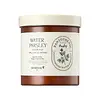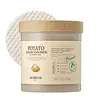What's inside
What's inside
 Key Ingredients
Key Ingredients

 Benefits
Benefits

 Concerns
Concerns

 Ingredients Side-by-side
Ingredients Side-by-side

Water
Skin ConditioningOenanthe Javanica Extract
AntimicrobialButylene Glycol
Humectant1,2-Hexanediol
Skin ConditioningDipropylene Glycol
HumectantCitrus Junos Fruit Extract
Skin ConditioningPanthenol
Skin ConditioningPPG-13-Decyltetradeceth-24
EmulsifyingBetaine
HumectantEthylhexylglycerin
Skin ConditioningFicus Carica Fruit Extract
HumectantAllantoin
Skin ConditioningGlycerin
HumectantPropanediol
SolventDiphenyl Dimethicone
EmollientTriethylhexanoin
MaskingCapryloyl Salicylic Acid
ExfoliatingCentella Asiatica Extract
CleansingSodium Citrate
BufferingSalvia Officinalis Leaf Extract
CleansingChamomilla Recutita Extract
Skin ConditioningDipotassium Glycyrrhizate
HumectantSodium Phytate
Polyglyceryl-10 Oleate
Skin ConditioningHydrogenated Lecithin
EmulsifyingSodium Hyaluronate
HumectantPhospholipids
Skin ConditioningRhodomyrtus Tomentosa Fruit Extract
HumectantEucalyptus Globulus Leaf Oil
PerfumingLeuconostoc/Radish Root Ferment Filtrate
AntimicrobialCitrus Aurantium Bergamia Fruit Oil
MaskingHelianthus Annuus Seed Oil
EmollientPantothenic Acid
Skin ConditioningSalvianolic Acid B
Skin ConditioningWater, Oenanthe Javanica Extract, Butylene Glycol, 1,2-Hexanediol, Dipropylene Glycol, Citrus Junos Fruit Extract, Panthenol, PPG-13-Decyltetradeceth-24, Betaine, Ethylhexylglycerin, Ficus Carica Fruit Extract, Allantoin, Glycerin, Propanediol, Diphenyl Dimethicone, Triethylhexanoin, Capryloyl Salicylic Acid, Centella Asiatica Extract, Sodium Citrate, Salvia Officinalis Leaf Extract, Chamomilla Recutita Extract, Dipotassium Glycyrrhizate, Sodium Phytate, Polyglyceryl-10 Oleate, Hydrogenated Lecithin, Sodium Hyaluronate, Phospholipids, Rhodomyrtus Tomentosa Fruit Extract, Eucalyptus Globulus Leaf Oil, Leuconostoc/Radish Root Ferment Filtrate, Citrus Aurantium Bergamia Fruit Oil, Helianthus Annuus Seed Oil, Pantothenic Acid, Salvianolic Acid B
Water
Skin ConditioningButylene Glycol
HumectantGlycerin
HumectantNiacinamide
Smoothing1,2-Hexanediol
Skin ConditioningHydroxyacetophenone
AntioxidantPPG-13-Decyltetradeceth-24
EmulsifyingBetaine
HumectantAllantoin
Skin ConditioningSodium Citrate
BufferingDipotassium Glycyrrhizate
HumectantSolanum Tuberosum Pulp Extract
SmoothingBeta-Glucan
Skin ConditioningCitric Acid
BufferingSodium Phytate
Sodium Hyaluronate
HumectantAmmonium Acryloyldimethyltaurate/Vp Copolymer
Helianthus Annuus Seed Oil
EmollientMadecassoside
AntioxidantSodium Ascorbyl Phosphate
AntioxidantGlyceryl Acrylate/Acrylic Acid Copolymer
HumectantPogostemon Cablin Leaf Oil
MaskingDipropylene Glycol
HumectantSclerotium Gum
Emulsion StabilisingPvm/Ma Copolymer
Emulsion StabilisingSalvia Officinalis Oil
MaskingHydrogenated Lecithin
EmulsifyingPolyglyceryl-10 Laurate
Skin ConditioningCentella Asiatica Extract
CleansingAsiaticoside
AntioxidantMadecassic Acid
Skin ConditioningAsiatic Acid
Skin ConditioningLavandula Angustifolia Oil
MaskingCaffeine
Skin ConditioningSalvia Sclarea Oil
MaskingRosmarinus Officinalis Leaf Oil
MaskingCaprylyl Glycol
EmollientWater, Butylene Glycol, Glycerin, Niacinamide, 1,2-Hexanediol, Hydroxyacetophenone, PPG-13-Decyltetradeceth-24, Betaine, Allantoin, Sodium Citrate, Dipotassium Glycyrrhizate, Solanum Tuberosum Pulp Extract, Beta-Glucan, Citric Acid, Sodium Phytate, Sodium Hyaluronate, Ammonium Acryloyldimethyltaurate/Vp Copolymer, Helianthus Annuus Seed Oil, Madecassoside, Sodium Ascorbyl Phosphate, Glyceryl Acrylate/Acrylic Acid Copolymer, Pogostemon Cablin Leaf Oil, Dipropylene Glycol, Sclerotium Gum, Pvm/Ma Copolymer, Salvia Officinalis Oil, Hydrogenated Lecithin, Polyglyceryl-10 Laurate, Centella Asiatica Extract, Asiaticoside, Madecassic Acid, Asiatic Acid, Lavandula Angustifolia Oil, Caffeine, Salvia Sclarea Oil, Rosmarinus Officinalis Leaf Oil, Caprylyl Glycol
 Reviews
Reviews

Ingredients Explained
These ingredients are found in both products.
Ingredients higher up in an ingredient list are typically present in a larger amount.
1,2-Hexanediol is a synthetic liquid and another multi-functional powerhouse.
It is a:
- Humectant, drawing moisture into the skin
- Emollient, helping to soften skin
- Solvent, dispersing and stabilizing formulas
- Preservative booster, enhancing the antimicrobial activity of other preservatives
Allantoin is a soothing ingredient known for its protective and moisturizingg properties. Because of this, it is often added to products with strong active ingredients.
Studies show higher concentrations of this ingredient can promote wound healing.
Though it can be derived from the comfrey plant, allantoin is produced synthetically for cosmetic products to ensure purity.
Learn more about AllantoinBetaine is a common humectant (a substance that promotes retention of moisture). It's known to be gentle on the skin and can help balance hydration.
This ingredient is best for improving hydration and soothing irritated skin. Studies also show it helps even out skin tone.
Fun fact: Betaine is naturally created in the skin and body. The kind found within cosmetic products can be either plant-derived or synthetic.
Another name for betaine is trimethylglycine.
Learn more about BetaineButylene Glycol (or BG) is used within cosmetic products for a few different reasons:
Overall, Butylene Glycol is a safe and well-rounded ingredient that works well with other ingredients.
Though this ingredient works well with most skin types, some people with sensitive skin may experience a reaction such as allergic rashes, closed comedones, or itchiness.
Learn more about Butylene GlycolCentella Asiatica Extract (Centella) is derived from an herb native to Southeast Asia. It is famous for its anti-inflammatory and soothing properties.
Centella is rich in antioxidants and amino acids, such as Madecassic Acid and Asiaticoside.
Studies show the compounds in centella help with:
The combination of all these properties makes centella effective at soothing, hydrating, and protecting the skin.
Other great components of centella include Vitamin A, vitamin C, several B vitamins, and Asiatic Acid.
Fun fact: Centella has been used as a medicine and in food for many centuries. As a medicine, it is used to treat burns, scratches, and wounds.
Learn more about Centella Asiatica ExtractDipotassium Glycyrrhizate comes from licorice root.
Extracts of licorice have demonstrated to have antibacterial, anti‐inflammatory, antiviral, antioxidant properties.
One component, glabridin, has extra potent antioxidant and soothing properties. It has also been found to block pigmentation from UVB rays in guinea pigs.
Licorice Root also contains a flavonoid. Flavonoids are a natural substance from in plants. Flavonoids also have antioxidant properties.
Another component, glycyrrhizin, has been found to have anti-inflammatory and antimicrobial benefits. This may make licorice root extract effective at treating acne. However, more research is needed to support this.
Liquiritin is one of the flavone compounds found in licorice. It has been found to help lighten skin by preventing tyrosinase from reacting with tyrosine. When the two react, protein is converted to melanin. Melanin is the substance in your body that gives your features pigmentation.
Licorice root is native to Southern Europe and Asia. It has been used in traditional Chinese medicine to help with respiratory issues.
Learn more about Dipotassium GlycyrrhizateDipropylene Glycol is a synthetically created humectant, stabilizer, and solvent.
This ingredient helps:
Dipropylene glycol is technically an alcohol, but it belongs to the glycol family (often considered part of the ‘good’ alcohols). This means it is hydrating and gentle on skin unlike drying solvent alcohols like denatured alcohol.
As a masking agent, Dipropylene Glycol can be used to cover the smell of other ingredients. However, it does not have a scent.
Studies show Dipropylene Glycol is considered safe to use in skincare.
Learn more about Dipropylene GlycolGlycerin is already naturally found in your skin. It helps moisturize and protect your skin.
A study from 2016 found glycerin to be more effective as a humectant than AHAs and hyaluronic acid.
As a humectant, it helps the skin stay hydrated by pulling moisture to your skin. The low molecular weight of glycerin allows it to pull moisture into the deeper layers of your skin.
Hydrated skin improves your skin barrier; Your skin barrier helps protect against irritants and bacteria.
Glycerin has also been found to have antimicrobial and antiviral properties. Due to these properties, glycerin is often used in wound and burn treatments.
In cosmetics, glycerin is usually derived from plants such as soybean or palm. However, it can also be sourced from animals, such as tallow or animal fat.
This ingredient is organic, colorless, odorless, and non-toxic.
Glycerin is the name for this ingredient in American English. British English uses Glycerol/Glycerine.
Learn more about GlycerinHelianthus Annuus Seed Oil is the oil derived from the seeds of a Sunflower. Sunflower seed oil is non-fragrant. It is an emollient, meaning it helps to soften the skin.
Sunflower seed oil contains many fatty acids. The fatty acids found in sunflower seeds include (from highest amount to least): linoleic acid, myristic acid, palmitic acid, stearic acid, arachidic acid, oleic acid, and linolenic acid.
These fatty acids help the skin create ceramides. Ceramides play a role in repairing the skin barrier.
Helianthus Annuus Seed Oil helps moisturize the skin. This in turn helps the skin look more rejuvenated and smoother.
Sunflowers are rich in vitamin E.
Historians believe Indigenous cultures of North America domesticated sunflowers before corn. Thus they relied on sunflower oil for a variety of uses. One such use is moisturizing skin and hair.
Sunflower seed oil may not be fungal acne safe. We recommend speaking with a professional if you have any concerns.
Learn more about Helianthus Annuus Seed OilHydrogenated Lecithin is created from the hydrogenation of lecithin (a group of phospholipids). Hydrogenation is a chemical reaction between hydrogen and another element.
This ingredient is an emollient and emulsifier. As an emollient, it helps soften skin by trapping moisture within. As an emulsifier, it prevents oil and water ingredients from separating.
We don't have a description for PPG-13-Decyltetradeceth-24 yet.
Sodium Citrate is the sodium salts of citric acid. In skincare, it is used to alter pH levels and acts as a preservative.
Its main functions are to maintain the pH of a product and neutralize metal ions.
The acidity of our skin is maintained by our glands and skin biome; normal pH level of skin is slightly acidic (~4.75-5.5).
Being slightly acidic allows our skin to create an "acid mantle". This acid mantle is a thin barrier that protects our skin from bacteria and contaminants.
Learn more about Sodium CitrateSodium Hyaluronate is hyaluronic acid's salt form. It is commonly derived from the sodium salt of hyaluronic acid.
Like hyaluronic acid, it is great at holding water and acts as a humectant. This makes it a great skin hydrating ingredient.
Sodium Hyaluronate is naturally occurring in our bodies and is mostly found in eye fluid and joints.
These are some other common types of Hyaluronic Acid:
Learn more about Sodium HyaluronateSodium Phytate is the synthetic salt form of phytic acid. Phytic acid is an antioxidant and can be found in plant seeds.
Sodium Phytate is a chelating agent. Chelating agents help prevent metals from binding to water. This helps stabilize the ingredients and the product.
Water. It's the most common cosmetic ingredient of all. You'll usually see it at the top of ingredient lists, meaning that it makes up the largest part of the product.
So why is it so popular? Water most often acts as a solvent - this means that it helps dissolve other ingredients into the formulation.
You'll also recognize water as that liquid we all need to stay alive. If you see this, drink a glass of water. Stay hydrated!
Learn more about Water